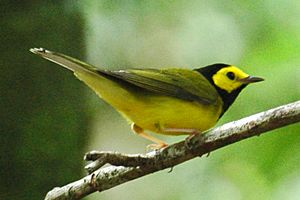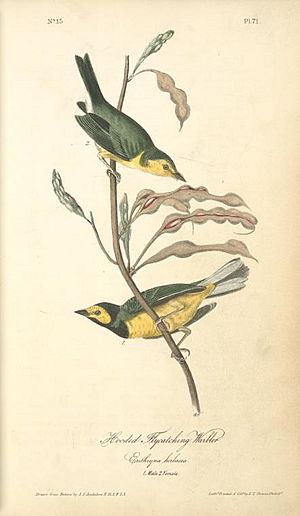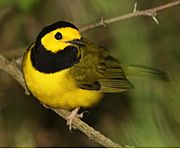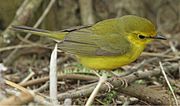Hooded warbler facts for kids
Quick facts for kids Hooded warbler |
|
|---|---|
 |
|
| Adult male | |
| Conservation status | |
| Scientific classification | |
 |
|
| Range of S. citrina Breeding range Wintering range | |
| Synonyms | |
|
Wilsonia citrina |
The hooded warbler (Setophaga citrina) is a small, colorful bird that lives in the forests of North America. It's a type of New World warbler, known for its bright yellow feathers and the male's unique black "hood." These birds spend their summers breeding in the eastern United States and southern Canada. When winter comes, they fly south to warmer places like Central America and the Caribbean. Sometimes, very rarely, they might even be seen in western Europe!
Contents
About Their Name
The hooded warbler got its first scientific name, Muscicapa citrina, in 1783 from a Dutch scientist named Pieter Boddaert. He based his description on a bird from Louisiana.
For a long time, this bird was placed in a group (genus) called Wilsonia. But scientists who study bird DNA found that the hooded warbler is actually more closely related to birds in the Setophaga group. Because the name Setophaga was used earlier (in 1827) than Wilsonia (in 1838), the rules of naming animals say that Setophaga takes priority.
So, the hooded warbler's official scientific name changed to Setophaga citrina. The name Setophaga comes from ancient Greek words meaning "moth-eating." The word citrina is Latin for "citrine," which means a yellow color, like a lemon. This fits the bird's bright yellow feathers!
What They Look Like
The hooded warbler is a small bird, about 13 cm (5.1 in) long. It weighs between 9–12 g (0.32–0.42 oz), which is about as much as a few paper clips! Its wingspan is around 17.5 cm (6.9 in).
These birds have an olive-green or brown back and bright yellow feathers on their belly. The outer tail feathers have white parts that you can see when they fly.
- Males: Adult males are easy to spot because they have a striking black "hood" that frames their bright yellow face. They get this hood when they are about 9 to 12 months old.
- Females: Females look a bit different. They have an olive-green cap on their head, but it doesn't cover their forehead, ears, or throat like the male's hood. Young birds look very similar to females.
The hooded warbler's song is very musical. It sounds like "wheeta wheeta whee-tee-oh." Some people remember it by saying "The red, the red T-shirt" or "Come to the woods or you won't see me." Their call is a loud "chip!"
Life and Habits
Hooded warblers mostly eat insects. They find their food in low plants and bushes. Sometimes, they even catch insects right out of the air while flying!
These birds like to live in broadleaf forests that have lots of thick bushes and plants close to the ground. This dense undergrowth provides good places for them to hide and find food.
Reproduction and Nesting
When it's time to have babies, hooded warblers build their nests in low bushes. Their nest is shaped like a cup, and the female lays three to five eggs inside.
Sometimes, hooded warblers become victims of "brood parasitism." This is when another bird, like the brown-headed cowbird, lays its eggs in the warbler's nest. The cowbird's eggs hatch, and the cowbird chicks are often bigger and take all the food, sometimes causing the warbler chicks to not survive. This happens more often in forests that are broken up into smaller pieces, making it harder for the warblers to find safe nesting spots.
Luckily, in areas where forests are protected or are growing back, the number of hooded warblers is stable and might even be increasing!
Gallery
See also
 In Spanish: Chipe encapuchado para niños
In Spanish: Chipe encapuchado para niños






